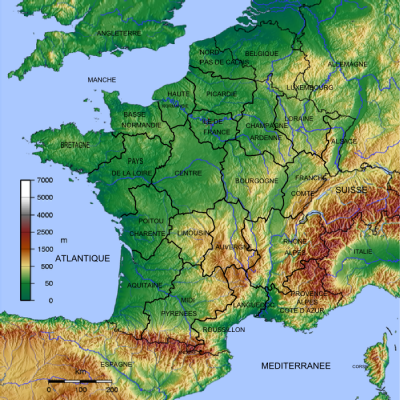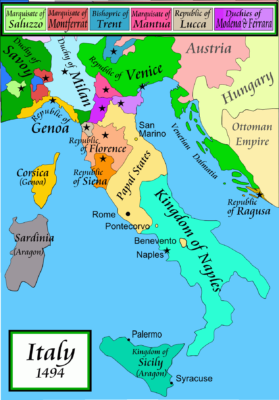
Italy and its new-found wealth lures the rising power, France. Continuing our series on France’s Wars. Did you ever notice that in almost every great war in history, France has been involved in some way? These stories emphasize the French role in these wars.
SUMMARY: It was too easy. When France invaded Italy in 1494, the French found a land filled with culture and riches but unable to defend itself. The temptation lured France into war after war even after the other major powers intervened and even after France was unable to contain the fighting to just Italy. Those other powers were tempted, too. As the decades advanced, France’s objectives changed from dominating to preventing others from dominating the peninsula.
DURATION: 1494-1559
BACKGROUND: The Renaissance had made the city-states of Italy the wealthiest on the planet. For France, 40 years had passed since the end of the Hundred Years War. The Black Plague was a bad memory. The advancements in military organization and weaponry from that war remained. When the first French army discovered that the walled cities of Italy could not withstand the gunnery of the French artillery, wealth, power, and glory beckoned irresistibly.
MAJOR COUNTRIES
- France
Growing strong; ready for adventure. - Opponents
- Spain: Came out of this great, going from zero territory in Italy to direct rule over Italy south of the Papal States and Milan in the north.
- Holy Roman Empire: Had a chance to gain true dominance in Europe, it failed due to opposition from France and the Ottoman Empire from without and Protestant destabilization from within.
- England: Henry VIII used the Reformation to confiscate the riches of the Catholic Church, he spent it all on Renaissance splendor for his court but mostly on wars in France. England gained nothing from these wars but debt which Elizabeth had to deal with.
- Ally
The Ottoman Empire: Another big gainer, it ended this period dominant in the Balkans. - Other
Papacy: Sometime ally, opponent, or neutral. Torn between the addressing spiritual challenges of the Reformation and the worldly challenges of gaining Italian territory during the age when it was most valuable, the Papacy chose to give priority to the latter, to its future sorrow. “Since God has seen fit to grant us the Papacy, let us enjoy it.” – Pope Leo X. Enough said.
MAJOR LEADERS
- France
Kings: Charles VIII (1483-1498); Louis XII (1498-1514); Francis I (1515-1547); and Henry II (1547-1559). - Papacy
The Popes: Alexander VI “Borgia” (1492-1503); Julius II “The Warrior Pope” (1503-1513); Leo X “de Medici” (1513-1521); Clement VII “de Medici” (1523-1534). - Holy Roman Empire
Maximilian I (1486-1519); Charles V of both the HRE and Spain (1519-1556). - Ottoman Empire
Suleiman the Magnificent (1520-1566).

CC BY-SA 3.0 image from Wikipedia.
NARRATIVE: This disregards the traditional names of these wars as meaningless. Each war was just part of this series of wars with causes that served as pretexts while leagues and alliances served as strategic moves. Like the conflicts making up the Hundred Years War, these conflicts were episodes of one 65 year-long war for dominance of the Italian peninsula.
1) War of 1494-1498
The Duke of Milan at the northern part of Italy asked Charles VIII of France to assist him in his war against Venice by encouraging him to take over Naples at the southern part of Italy. This was how it all started.
Charles bought peace with the other powers by giving French provinces in the south to Spain and French provinces in the north and east to Maximilian of the Holy Roman Empire. Then he invaded Italy and triumphantly marched down its length to Naples.
Returning back to France proved the problem as the Italian powers united against him. In the drawn Battle of Fornovo they got in among his baggage, though the French army managed to beat their way through the main Italian army. Charles returned to France with his booty gone. Meanwhile, down south, the Spanish defeated the French Naples and restored that Kingdom albeit as a Spanish protectorate.
In the end, this war was a net loss to France, as the provinces ceded to Spain and the Hapsburgs prior to active operations remained lost.
2) War of 1499-1504
France invaded again and took over the Duchy of Milan. This was a worthwhile conquest, not only because this was a rich area but also because of its proximity to the French homeland. Louis XII wanted faraway Naples, too. This led to direct conflict with Spain which France lost. The war ended with France keeping Milan and the upper hand in northern Italy and Spain keeping Naples and Sicily, too, and supremacy in southern Italy.
3) War of 1508-1516
France was unable to contain this war to Italy. Eventually it was fought on multiple fronts with Spain, Germany under the Holy Roman Empire, and England. France allied with Scotland, thus giving England a second front, too. After loosing Milan to Switzerland, France retook it, gaining a peace treaty which kept her territory.
4) War of 1521-1526
When Maximilian I of the Holy Roman Empire died in 1519, both Francis I, King of France and Charles V, King of Spain campaigned to succeed him. When Charles won the vote, Francis attacked. The main fighting occurred in Flanders and on the Rhine but in Italy Francis lost the decisive battle of Pavia in 1525 and was captured. France lost everything in Italy. In a desperate Hail Mary pass, France allied with the Ottoman Empire. The Ottoman sultan Suleiman the Magnificent invaded the Balkans, winning the decisive Battle of Mohacs in 1526 which had the grand strategic outcome of winning Hungary and lands south for the Ottomans and of bringing Charles to the peace table.
5) War of 1526-1530
Considering that Charles V now united the might of both the Holy Roman Empire and Spain’s growing worldwide Empire and considering his growing dominance in Europe after the last war, the rest of the powers united to preserve a balance of power. This war featured more defeats for France but Francis got off easy since Charles V let him off early so he could concentrate on the rest of the coalition against him. The big losers were the independent Italian city-states. This was the war where Charles’ Imperial Army sacked Rome. Venice lost territory and Florence lost its republican form of government.
6) War of 1536-1538
The last war had left Charles V in pretty good shape. As King of Spain, he dominated the southern half of Italy. As Holy Roman Emperor with his power centered in Germany, he dominated the northern half of Italy. What kept the peace was that he did not rule directly but dominated through puppet rulers instead. France and others could at least maintain theoretical claims on Italian territory. When his Duke of Milan died, Charles put another puppet in his place, the illusion of diplomatic rights was shattered. Francis again allied with the Ottomans and declared war. This time he captured Turin but failed in his primary objective in re-taking Milan. At last he had got something, though.
7) War of 1542-1546
The underlying conflicts of interest between Francis and Charles were not resolved by the last war. In 1542 Francis felt strong enough to resume the fight. This time the Ottoman Empire sent a fleet around Italy that hooked up with the French to capture the city of Nice. Further gains were offset in northern France when Charles invaded from Luxemburg and from Germany while the English under Henry VIII invaded from their port at Calais. The English captured the city of Boulogne. Francis had to make massive transfers from the Italian front to shore up the northern front. This stabilized the situation and France got back to the status quo before the war.
8) War of 1551-1559
When Francis I died, Henry II took up the torch. During this war Charles V abdicated and his domains were split between Spanish and the German/Austrian Hapsburgs. Henry’s French were again repulsed in the Italian Front but on the Rhine Front they walked away from this war with the territories of Metz, Toul, and Verdun. These remain in French hands to this day.
AFTERMATH: France was impoverished by these wars. While it had gained the 3 territories in the last war, it still had lost the 4 territories Charles VIII had given away just before the first of these wars. During this era Francis I had met Leonardo da Vinci who had agreed to move to France and to take his Mona Lisa with him. That painting still hangs in the Louvre in Paris. The Reformation gained vastly during this period; it greatly hampered Charles V’s base in Germany. Now France was to face its effects.
| <—Previous | Master List | Next—> |
Further Information: here and here and below.
 |
Leave a Reply
You must be logged in to post a comment.